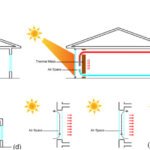Top Innovative Uses of Concrete in Architecture
- By -Peter
- Posted on
- Posted in Modern Architecture
Have you ever wondered how concrete, that sturdy grey stuff we see everywhere, can be so versatile and exciting in architecture? It’s not just about sidewalks and skyscrapers anymore. Concrete in architecture has taken on a whole new life, pushing boundaries and redefining what’s possible. Let’s take a look at some of the most innovative ways architects are using concrete today.
Innovative Uses of Concrete in Architecture
Sculptural Statements: Beyond Straight Lines
Concrete isn’t just for straight lines and right angles anymore. Architects are using its moldable nature to create stunning sculptures in the form of buildings. Think about the sweeping curves of the Sydney Opera House or the bold angles of the Walt Disney Concert Hall in Los Angeles. These structures show how concrete can be moulded into almost any shape, allowing architects to unleash their creativity and make architectural statements that captivate.

Green and Clean: Concrete for Sustainability
Concrete isn’t just strong; it’s also environmentally friendly when used smartly. Architects are incorporating concrete in sustainable building designs to help reduce energy use. Its thermal mass properties can help regulate indoor temperatures naturally, cutting down on heating and cooling costs. Some concrete mixes even help clean the air by neutralizing pollutants. It’s a win-win for both builders and the planet.
Adaptive Reuse: Reinventing Old Spaces
One of the coolest things about concrete is its ability to breathe new life into old spaces. Architects are turning abandoned factories, warehouses, and even bunkers into vibrant new buildings without tearing them down. Places like the Tate Modern in London or the High Line in New York City showcase how concrete can preserve history while creating something entirely new and exciting.
High-Tech Concrete: Smart Buildings of the Future
Concrete might seem old-school, but it’s getting a high-tech upgrade. Architects are embedding sensors into concrete buildings to monitor their health in real time. This smart concrete can detect cracks early, ensuring buildings stay safe and sturdy. Some buildings even use translucent concrete that lets natural light in while keeping the structure strong. It’s a glimpse into the future of smart, sustainable architecture.
Urban Oasis: Concrete in Public Spaces
Concrete isn’t just for buildings; it’s also shaping our public spaces. Architects are using concrete to create parks, plazas, and even playgrounds that blend seamlessly into urban environments. These spaces aren’t just functional; they’re beautiful too, with concrete’s durability ensuring they’ll be enjoyed for years to come.
Prefab Power: Faster, Cheaper, Stronger
Prefab concrete panels are changing the way buildings go up. Instead of pouring concrete onsite, builders can now create sections in a factory and assemble them like giant Legos. It’s faster, cheaper, and often stronger than traditional building methods. Prefab concrete is helping to create everything from affordable housing to emergency shelters quickly and efficiently.
Bioclimatic Design: Working with Mother Nature
Concrete isn’t just about brute strength; it’s also smart about energy use. Architects use concrete’s ability to absorb and release heat slowly to create buildings that stay cool in summer and warm in winter without a lot of energy. It’s called bioclimatic design, and it’s helping to create buildings that work with nature instead of against it.
Cultural Preservation: Saving the Past for the Future
Concrete is also helping to preserve our cultural heritage. Architects are using advanced techniques to restore and protect ancient concrete structures, ensuring they’ll be around for future generations to enjoy. From ancient Roman aqueducts to modernist masterpieces, concrete is helping to keep history alive.
Conclusion
Concrete in architecture isn’t just about strength and stability anymore. It’s about creativity, sustainability, and innovation. From sculptural masterpieces to sustainable urban solutions, concrete continues to surprise and inspire. As technology advances and architects push the boundaries of what’s possible, concrete will remain a cornerstone of modern architecture. It’s more than just a material; it’s the building block of the future, shaping the cities and spaces where we live, work, and play. So next time you see a concrete building, take a moment to appreciate the creativity and innovation that went into making it more than just a structure—a work of art that stands the test of time.



